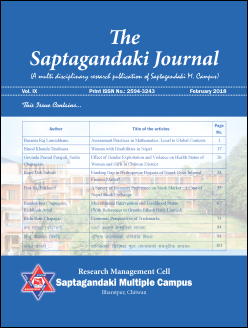Microfinance Intervention and Livelihood Status: A Case of Gramin Bikash Bank Limited
DOI:
https://doi.org/10.3126/sj.v9i0.20881Keywords:
Microfinance, Intervention, Non- intervention, Remote, Income level, Capital expenditure, Occupational status, Consumption expenditure, Information access, Livelihood statusAbstract
This paper attempts to focus on the impact of micro finance intervention on livelihood status of the people taking samples of 60 respondents of microfinance intervened and 60 non intervened population of Grameen Bikash Bank which lies on remote area of Pokhara, Leknath Metropolitan city and nearby VDCs. The study is based on the randomized control trial approach and data were collected through researcher administered questionnaire. Respondents were taken through stratified sampling. The research finds that microfinance intervention has association with occupational status, micro enterprise creation, frequency of loan taken and occupational change. Independent sample t-test shows micro finance intervention increases income level, capital expenditure, consumption expenditure and saving. The regression analysis shows that micro finance intervention changes the livelihood status of women of rural areas of Pokhara Municipality and nearby VDCs.
The Sapta Gandaki Journal
Vol. IX, 2018 Feb. Page: 62-72
Downloads
Downloads
Published
How to Cite
Issue
Section
License
© The Saptagandaki Journal
The author of article must sign the copyright permission or the author must assign copyright to the Journal/to the Campus Authority prior to publication.
All rights reserved.




